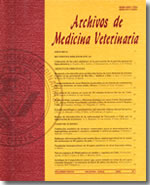Effect of alkali treated wheat straw on intake and ingestive behaviour in dairy cows
Main Article Content
Abstract
With the purpose of determining the effects of feeding increasing levels of alkali treated wheat straw on feed intake and ingestive behaviour, twelve Holstein cows in mid lactation (154 DIM) were grouped according to milk production DIM and parity, into 4 blocks and assigned to four, 3 x 3 crossover Latin Squares (3 treatments and 3 periods of 21 days each). All cows were fed rations with a fixed proportion of 70% forage, 30% concentrate (DM), and kept tethered in individual tie stalls with free access to water. The three treatments were: T1 a control, fed grass silage as the only forage, T2; part of the grass silage was substituted for treated straw, offered at a level of 10% of the daily ration, in T3, straw was offered at 20% of the daily ration. The concentrate was kept the same across treatments and consisted of a mixture of 88,41% commercial concentrate and 11.59% of a premix (55.3% fish meal; 30.0% mineral mix and 14.7% urea). Wheat straw was chopped (3-4 cm) and treated on a daily basis with a solution of NaOH (34 gr. per kg of straw, diluted in 3 litres of water). Twenty-four hours after treatment the treated straw was manually mixed with grass silage and offered on an individual basis. Intake was measured daily on an individual basis and feeding behaviour was recorded every 5 minutes during two separate episodes of 24 hours per period. The alkali treatment of straw increased its energy value (from 1.75 to 2.23 Mcal/kg of DM) and reduced its FDN concentration (from 85.47 to 75.10% DM), but increased its ash content (from 3.98% to 8.41%, DM). The average intake of forages (18.1 kg DM/day) and FDN (9.1 kg/ day) was similar among treatments. The inclusion of straw in the diet decreased the time devoted to forage intake from 441.3 min (T1) to 407.6 min (T3) (p<0.05). Cows in T3 ruminated less time (551.5 min) than those in T1 (522.4 min) (p<0.05). T1 had a higher number of meals per day (13.7) than T3 cows (12) (p<0.05). Meal length however, did not differ (avg. 37.5 min). The average of ruminating periods did not differ but its length increased with treated straw (37.2 and 36.4 min for T2 and 73, respectively) being 32.8 for T1 cows (p<0.05). The fibrosity index of the diets (min eating + ruminating/kg of DM consumed) was correlated (r2 = 0.8) with a decrease in intake rate for the 3 diets.

